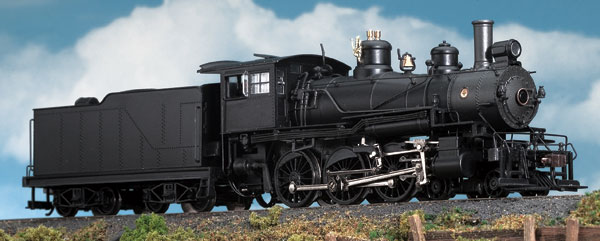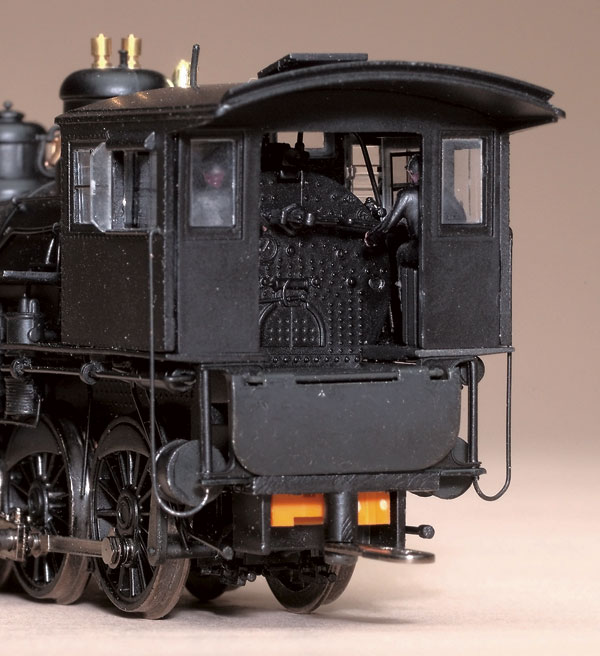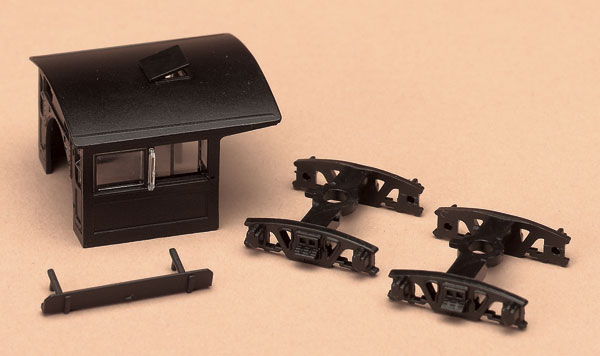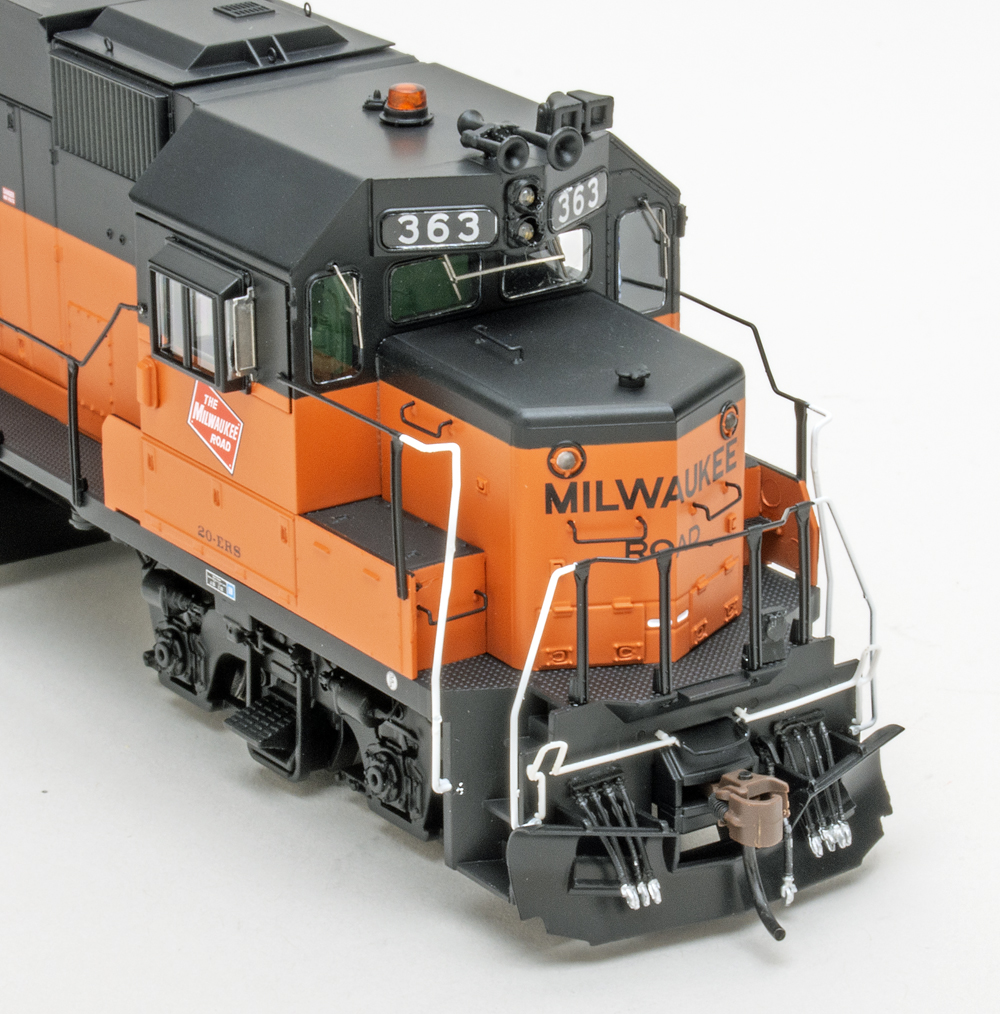The manufacturer claims no prototype for this model beyond being representative of Baldwin Locomotive Works designs of the early twentieth century. While its size and proportions reflect that era, its detailing suggests a locomotive modernized in the 1920s or later, that may have run into the 1950s. The locomotive retains the slide-valve cylinders of the era when it was supposedly built, but has more-modern Walschaerts valve gear, electric lighting, and a steel cab.
With 63″ drivers and a narrow firebox carried between the rear drivers rather than above them, it has more in common with 4-6-0s built for freight or dual service than with fast passenger engines. Since I was not able to compare it closely with a specific prototype, I’m listing the locomotive’s major dimensions in the data box on page 17.
The new Ten-Wheeler, like Bachmann’s HO scale Shay, has a cast zinc alloy boiler and cab. This makes for a heavier engine than one with a plastic superstructure and a metal core. The many free-standing details include appliances and piping molded in flexible plastic as well as wire parts. The cab has a detailed backhead and a crew.
The undecorated model shown includes three alternate parts the buyer may substitute: a cast-metal simulated wooden cab, a plastic footboard pilot, and Andrews tender-truck frames.
The boiler may be removed by unscrewing four screws, one between the cylinders and three at the rear of the frame and under the cab. The deck braces must also be removed from the sides of the smokebox. The motor and flywheel are enclosed in a metal housing that fills a cavity in the boiler casting. A cogged belt drives a worm shaft that runs horizontally below the motor, and the worm drives a worm gear on the main (second) driver.
The locomotive picks up current from all drivers by means of phosphor-bronze contacts that bear on the metal tires. All of the wheels (including the tender trucks) are painted black.
For the most part, the rods and valve gear are well-executed in plated metal. However, the valve-stem-crosshead guides on each side slope downward from the valve gear hanger to the valve chests, whereas they should be level and parallel to the main crosshead guides. The eccentric cranks are only slightly eccentric (off center) and would not provide sufficient motion to operate the valves on a real engine.
The tender is mostly plastic, with metal weights, handrails, wheels, and current pickups. The uninsulated wheels are arranged so that each truck picks up current on one rail. Two plugs, one with two pins and one with four, connect wires from the tender to sockets under the cab.
A PC board inside the tender provides constant directional lighting and includes a Digital Command Control (DCC) socket as recommended by the National Model Railroad Association. A jumper plug allows the locomotive to operate on conventional DC.
Performance
The Ten-Wheeler ran a little roughly right out of the box, especially at slow speeds. It smoothed out considerably after about 20 minutes or so of running. Its starting voltage might seem high, but that’s an effect of the constant lighting diodes. Its overall speed range is very good, though its top speed is a little high. The headlight didn’t work on our sample, and the backup light’s LED gives off a bluish glow. (Bachmann will replace any model that doesn’t operate properly, but we’re compelled by deadlines to describe the one we received.)
The 4-6-0’s pulling power is respectable for an engine of this size – it’s not meant to be a tonnage hog. I found that most of the wheelsets were narrow in gauge, but the engine and tender ran smoothly through both Atlas Snap Switches and the handlaid turnouts on my home layout. The wheels are very tight on their axles, so adjustments will require a wheel-puller.
I plugged a Digitrax DH-140 decoder into the tender socket and tried running the Ten-Wheeler on DCC. It performed properly, and function 0 controlled the backup light (the headlight still didn’t work). The lights operate directionally in DCC, with the backup light on in reverse and off in forward motion.
More to come
Bachmann plans to offer then Ten-Wheeler in a low-boilered version with detail variations appropriate to the prototype road names. There will also be two other tenders: a larger type and a smaller, flared-top version that will have an optional fuel-oil bunker.
The Spectrum 4-6-0 is an attractive model and will be at home on many different layouts. It’s especially nice, though, to have such a good engine for small to medium-size model railroads.
Price: $175
Manufacturer:
Bachmann Industries Inc.
1400 E. Erie Ave.
Philadelphia, PA 19124
215-533-1600
www.bachmanntrains.com
Description:
Spectrum series metal and plastic ready-to-run steam locomotive
Road names:
Painted, unlettered (shown here), Chicago & North Western, and New York Central
(low-boiler versions with specific railroad details will be offered in Maryland & Pennsylvania, Southern Ry., and Union Pacific)
Dimensions:
- Boiler: maximum diameter over jacket, 71″; jacket diameter at the smokebox, 62½”; smokebox diameter, 62″; pitch (center line above rail), 101″; firebox (outside), 40″ x 109″
- Length: locomotive, 36′-0″; tender, 28′-6″; overall, 66′-6″
- Height: cab, 14′-2″; coal bunker, 11′-10″; smokestack, 14″-5½”; tender water tank, 10′-6″
- Width: cab, 9′-10″; cylinders, 9′-11″; tender, 10′-2½”
- Wheel diameters: drivers, 63″; engine truck, 28″; tender, 33″
Features:
Detailed cab interior and crew
Drawbar pull: 1.76 ounces (equivalent to 25 free-rolling cars on straight, level track)
Engine weight: 9.5 ounces (plus 2.5 ounces for tender)
E-Z Mate magnetic knuckle couplers front and rear (.015″ to .020″ high)
Minimum radius: 15″
Nickel-silver RP25 wheelsets. All but one tender wheelset are narrow in gauge (drivers measure .560″ back-to-back, while the minimum listed in National Model Railroad Association standard S-4 is .566″)
Zinc alloy construction


















The 63" driver version is pretty close to MP, T&P, and L&A prototypes ….. very good for model railroaders in Louisiana, Arkansas, and Texas who don't have many regional-specific models available.
The 52" driver is supposedly a Ma and Pa engine, and they did have one, but it is really a stock model Baldwin 4-6-0, not unlike the way the GP-7's were stock offerings. Very similar engines ran on the Y&MV and the Mississippi Central and that model is very usable for those modeling these southern roads.
Would it be possible to convert it to a wood burner? Maybe I could use the shay diamond stack, and use the bunker for the bachmann HO 4-4-0. What do you think Andy Sperandeo
Great looking model and runs great when it stays on the track
The cables tend to lift the tender
On my DC version I eliminated the cable had connected the engine pickup power rgight to the motor and light
However on my DCC version that can't be done and it is a real pain trying to keep it on the track
Bachmann ought to eliminate the power pickup in the engine and just have a single cable from the tender to the motor and tie the light into it inside the engine
Where can I get it for $175? On Bachmann's site, it's $360, with DCC and sound, and the next best is $190 for sale on Caboose Hobbies site.
Never ran mine on DC. Installed DCC with sound and it runs great. Needed to adjust CVs for optimum performance. Detail is wonderful. Only issue is that it wants to stall on Walthers curved #6 switches (DCC compatible). I have not found the resolution yet, but that is because I have not spent time on it yet.
Great model. I have both versions, they both look and run nicely. Keep the nice steam loco's coming!!
I worry about the drive belt. Mine has come off and it is tough to put it back on.
I purchased the Maryland and Pennsylvania version because it is a very good representation of the prototype which I used to see operating through Baltimore in the early 1950's. Unfortunately it has an operating problem I have not been able to solve. The wires between the loco and tender hang so low that they get caught on switches and crossings. Any suggestions?
My Bachmann 4-6-0 sounds and runs GRATE…Looks Cool, Nice job Bachmann, im so pleased i just orderd your Decapod.
Another beautifull machine from Bachmann, but really, today is becoming quite difficult (or impossible) to find a model that doesn't looks and performs top!
In the '50's the NKP ran a morning passenger thru Celina,OH that was westbound between Cleveland and St. Louis. I've been looking for an HO 4-6-0 that has a similar look to it.
purchased the low boiler version with 52" drivers lettered for maryland and pennsylvania runs and looks nice
Tends to stall thru' turnouts, due, I think to the rigid short wheelbase, & wheels lifting off the track minutely due to imperfections in track laying & "bowing" of some brands of turnouts. Existing wheel pickups also play a part. Tender pickups should compensate, but tender is very light weight.
Solution: try extra weight in tender, add extra phosphor-bronze pickups to tender or loco
I had the same problem Bill from Maryland mentioned. Solved it by tying a 4" wire tie around the 4-wire cable, clipping the tail close to the ratchet box, then gluing the tie to the underside of the tender frame with CA, pulling the wires up and away from the way they hang down, interfering with track.
Painted the assembly grimy black and its barely noticeable, major improvement to operation